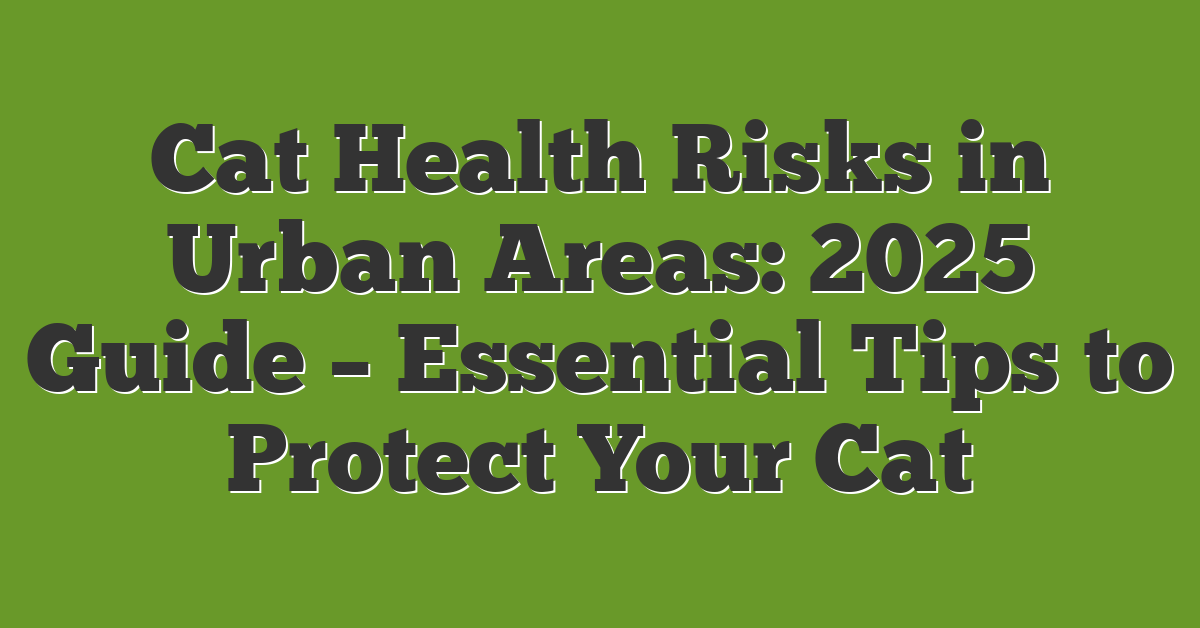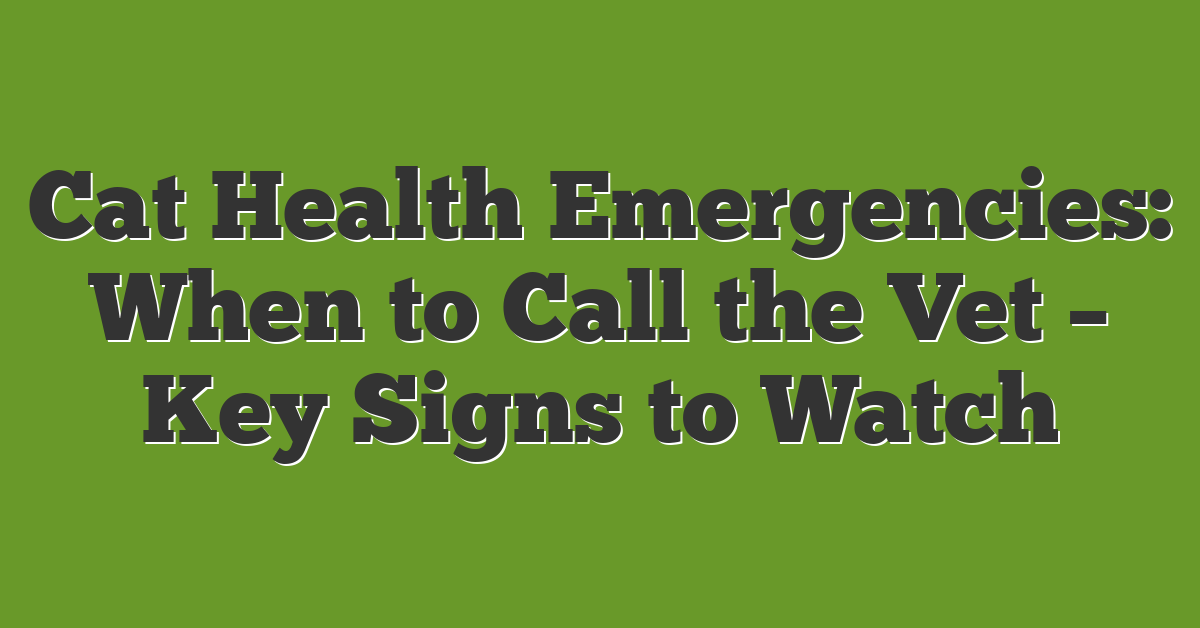Living in the city offers endless adventures, but it also introduces specific health challenges for your cat. You want to ensure your feline stays safe and well in the urban landscape.

From air pollution and noisy streets to limited outdoor spaces, urban living can impact your cat’s well-being in unexpected ways. Recognizing these risks allows you to take proactive steps in maintaining your pet’s health.
This 2025 guide provides you with essential insights and practical tips to help your cat thrive amidst the concrete and chaos of city life.
Overview Of Urban Cat Health Risks
Living in the city exposes your cat to several health risks. Understanding these can help you keep your feline friend safe and healthy.
Air Pollution
Cities often have high levels of air pollution. Pollutants like smoke, chemicals, and dust can cause respiratory problems in cats. Long-term exposure may lead to chronic issues.
Noise Pollution
Loud noises from traffic, construction, and nightlife can stress your cat. Chronic stress can weaken their immune system and affect their behavior.
Limited Outdoor Spaces
Urban areas have fewer safe outdoor spaces. Without sufficient exercise, cats may become overweight or develop behavioral problems. Restricted environments can also limit their natural instincts.
Traffic Hazards
Cats that roam outdoors face the danger of being hit by vehicles. Traffic-related accidents are a leading cause of injury and death in urban cats.
Exposure to Diseases
High population densities increase the risk of infectious diseases. Cats in cities may come into contact with more sick animals, raising the chances of illness.
Indoor Hazards
Living indoors might seem safer, but urban homes can have hazards like toxic plants, household chemicals, and small objects that cats can ingest or get injured by.
Stress and Mental Health
The fast-paced city life can increase your cat’s stress levels. Stress can lead to anxiety, aggression, and other mental health issues.
Access to Veterinary Care
While cities usually have more veterinary clinics, the high demand can lead to longer wait times and higher costs for medical care.
Nutrition Challenges
Urban environments may limit access to fresh, quality food. Poor nutrition can result in obesity, diabetes, and other health problems in cats.
Table: Common Urban Health Risks for Cats
| Health Risk | Potential Effects |
|---|---|
| Air Pollution | Respiratory issues, chronic illnesses |
| Noise Pollution | Stress, weakened immune system |
| Limited Outdoor Spaces | Obesity, behavioral problems |
| Traffic Hazards | Injuries, fatalities |
| Exposure to Diseases | Increased illness risk |
| Indoor Hazards | Accidental poisoning, injuries |
| Stress and Mental Health | Anxiety, aggression |
| Access to Veterinary Care | Higher costs, longer waits |
| Nutrition Challenges | Obesity, diabetes |
Understanding these risks helps you take steps to protect your cat in an urban environment.
Common Health Issues
Urban living exposes your cat to various health challenges. Being aware of these issues helps you protect your feline companion.
Respiratory Problems
City air often contains pollutants like smoke, car exhaust, and dust. These irritate your cat’s lungs, causing coughing and sneezing. Long-term exposure can lead to asthma or bronchitis. Keep your cat indoors on high pollution days and use air purifiers to reduce harmful particles.
Infectious Diseases
High population density in cities increases the risk of infectious diseases for your cat. Viruses like feline herpesvirus and feline leukemia virus spread more easily. Ensure your cat receives regular vaccinations and veterinary check-ups. Maintaining good hygiene and limiting contact with stray animals also help prevent these diseases.
Environmental Hazards
Urban environments present various hazards that can affect your cat’s health. Understanding these risks helps you create a safer home for your feline friend.
Pollution Exposure
Air pollution poses significant risks to your cat’s respiratory health. High levels of pollutants like nitrogen dioxide and particulate matter can cause asthma and bronchitis. For instance, cats living near busy streets may inhale more car exhaust, increasing their chances of developing breathing issues. Keep your home well-ventilated and use air purifiers to reduce indoor pollution levels.
Water contamination is another concern. Urban areas may have polluted water sources containing heavy metals and chemicals. Ensure your cat drinks clean, filtered water to prevent kidney problems and other health issues. Regularly check your local water quality reports to stay informed about potential risks.
Traffic And Accidents
Traffic is a major danger for outdoor cats. Vehicles can injure or even kill your cat if they roam near busy roads. For example, studies show that thousands of cats are hit by cars each year in major cities. To minimize this risk, keep your cat indoors or provide a secure outdoor enclosure.
Additionally, traffic noise can cause stress and anxiety in cats. Loud sounds from cars and construction can lead to behavioral problems like hiding or aggression. Creating a calm indoor environment with safe spaces helps reduce stress and keeps your cat comfortable in the urban setting.
Prevention And Care
Keeping your cat healthy in the city involves proactive steps. Implement these strategies to minimize health risks and ensure your feline’s well-being.
Regular Veterinary Checkups
Schedule vet visits at least twice a year. Regular checkups detect issues early. Vaccinations keep diseases at bay. Parasite prevention protects against fleas and ticks. Discuss any behavioral changes with your vet promptly.
Safe Outdoor Practices
Create secure outdoor spaces for your cat. Use harnesses and leashes during walks. Supervise outdoor time to prevent accidents. Ensure your yard is free from toxic plants and chemicals. Consider installing cat-proof fencing to keep your pet safe.
Future Trends And Research
Research on urban cat health continues to grow. Scientists focus on how city living affects your cat’s well-being. New studies explore the link between air pollution and respiratory issues in cats. Understanding these connections helps develop better care strategies.
Technology plays a big role in future trends. Wearable devices track your cat’s activity and health. Apps help monitor their behavior and schedule vet visits. These tools make it easier to keep your cat healthy in a busy city environment.
Urban planning is changing to support pet health. More green spaces and cat-friendly parks are being designed. These areas give your cat safe places to explore and reduce stress from crowded streets. Secure outdoor enclosures are also becoming popular, allowing cats to enjoy the outdoors safely.
Veterinary medicine is advancing with new treatments. Preventive measures like improved vaccines and parasite control are being developed. These advancements help protect your cat from diseases common in urban areas. Telemedicine is also growing, making it easier to consult vets without leaving home.
Studies on indoor enrichment are gaining attention. Providing toys, climbing structures, and interactive environments keeps your cat mentally healthy. Research shows that enriched environments reduce anxiety and prevent behavioral issues. Implementing these findings can enhance your cat’s quality of life.
Pollution research remains a priority. Scientists investigate how different pollutants affect cats’ health. Findings guide the creation of cleaner indoor spaces and better air quality solutions. By staying informed, you can take steps to minimize your cat’s exposure to harmful pollutants.
Overall, future trends and research aim to improve the lives of urban cats. Staying updated on these developments helps you provide the best care for your feline friend.
Conclusion
Keeping your cat healthy in the city is all about understanding their unique needs. By being aware of the challenges urban environments pose, you can create a safe and nurturing space for your furry friend. Regular vet visits and a balanced diet go a long way in preventing health issues. Providing indoor enrichment and secure outdoor areas helps your cat stay active and happy without the risks of the urban jungle. Staying informed about the latest trends and research ensures you’re taking the best steps for your pet’s well-being. With a little extra care and attention, your cat can thrive amidst the hustle and bustle of city life.
















